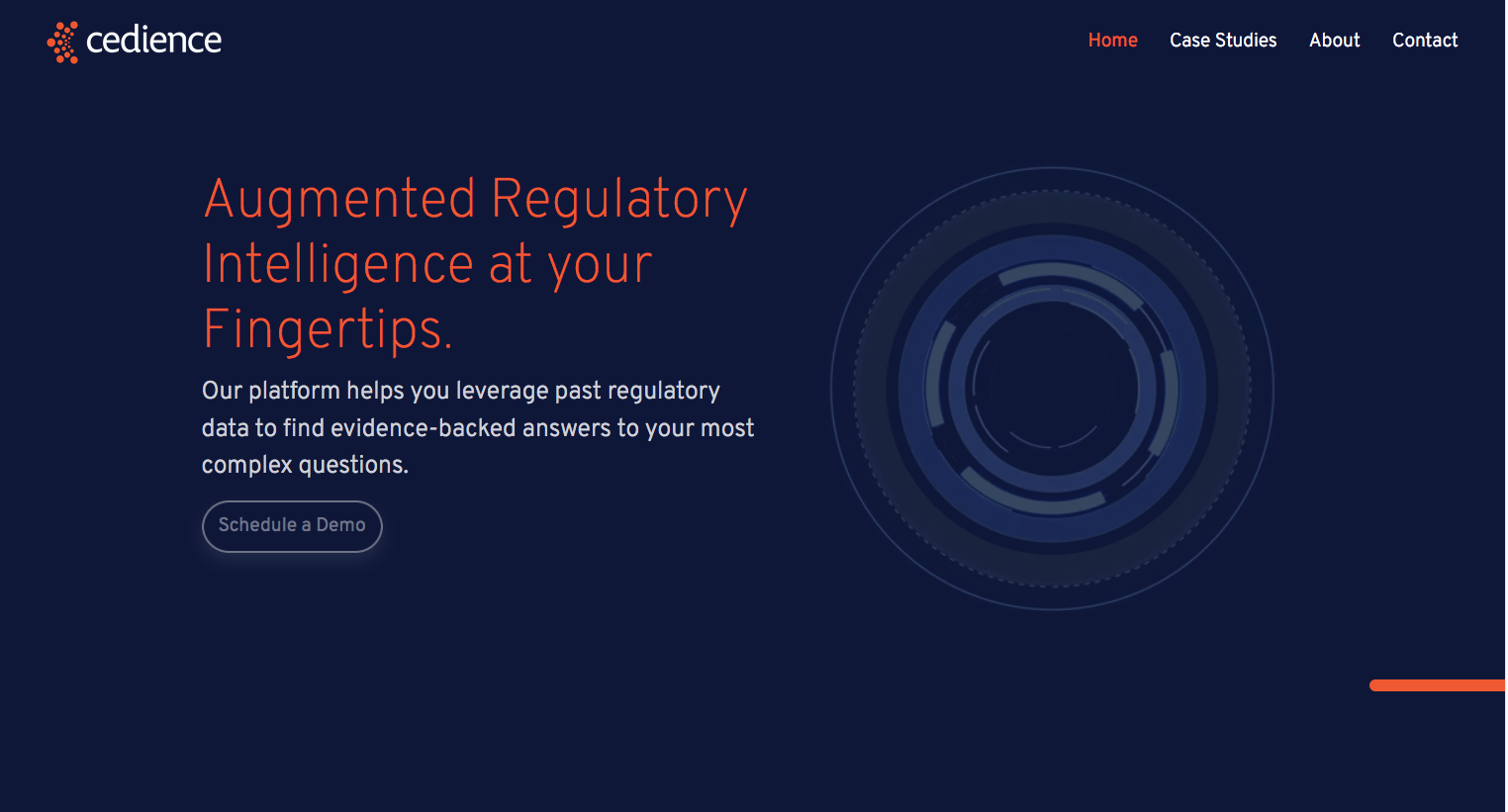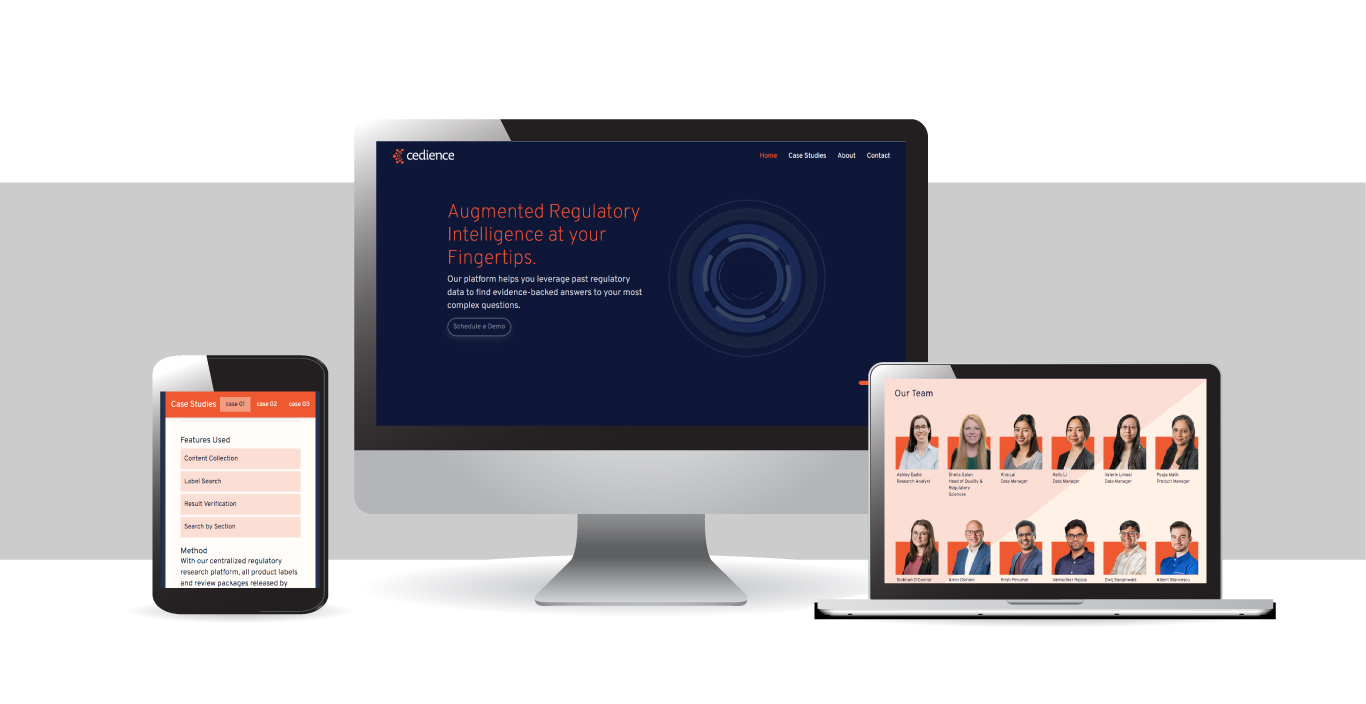Augmented Regulatory Intelligence
Transforming Brand Identity and User Experience for a Life Sciences SaaS Platform
Cedience is a regulatory intelligence platform designed for the life sciences sector, utilizing AI technologies, specifically Natural Language Processing and Machine Learning, to assist drug development teams in navigating complex regulatory landscapes. By centralizing vast amounts of regulatory data, Cedience enables users to find evidence-backed answers to regulatory questions in minutes—a process that traditionally took weeks or months. This efficiency transforms how teams handle regulatory inquiries, supporting faster decision-making in drug development.
Cedience encountered a major challenge: its brand and digital presence did not accurately represent the innovative and dynamic nature of its technology. The web application frustrated users with a confusing search function, preventing them from utilizing the AI tool as intended to create the experiences envisioned by the founders. Additionally, they were working to integrate other AI features that required input on user experience.
This case study outlines my role as the lead in transforming Cedience's brand and demonstrates how I was able to quadruple user engagement for their AI web application tool. This achievement occurred during my time at Boavi, the company I founded and led, before moving on to my current endeavors.

The Challenge
Cedience approached Boavi with three main challenges:
- Brand and Website: The original company name failed to reflect Cedience's cutting-edge AI solutions, which confused potential users and diminished the brand's impact. Additionally, the website did not effectively market these offerings.
- AI Web Application tool: Cedience's tool was overwhelmed with counterintuitive features, making it difficult for users to navigate and understand the value it offered. An example is the search function at the core of Cedience's web application, which caused significant user frustration. They also had new AI features they wanted to implement.
Discovery and Insights
We started with several discovery sessions to gather insights from the Cedience team. Understanding their goals and challenges was crucial for identifying the core of their brand. As an AI-driven platform, we also focused on understanding their vision and the desired outcomes of their application. Our goal was to bring that essence to the forefront.
The discovery session revealed that although Cedience's technology was innovative, the brand and user engagement with the tool were not keeping pace.
Brand & Website
Brand Identity
The name Cedience had to evoke authority, intelligence, and simplicity. We conducted extensive research, studying industry-specific language, its usage, and even pronunciation to ensure the name would resonate with the target audience. The result was Cedience—a name derived from the fusion of "Precedents" and "Evidence," symbolizing the platform's core function of providing intelligent regulatory answers by leveraging past data and regulatory precedents.
With a fresh name came a full rebranding, including logo design, typography, and a modern color palette. Every visual element was crafted to reflect Cedience's AI-driven innovation. We produced brand guidelines to maintain consistency across all touchpoints, from online to print.
Website
We revamped the website to effectively market their tool, generate more leads for potential users, and provide information to investors.
- Interactive Case Studies: Rather than simple text-based reports, we created vibrant case studies using interactive graphs and data sets to engage users, particularly those in the drug development and medical fields. These dynamic elements made data exploration both intuitive and visually compelling for investors.
- Call to Action: We strategically placed call-to-action buttons throughout key areas of the website to guide users effectively, drive engagement, and boost lead generation.
- Visual Storytelling: Understanding that Cedience's audience consists of data-focused professionals, we strategically integrated visually compelling statistics and graphs on the homepage. These elements were designed to immediately communicate the brand's value proposition. To address the pain points of regulatory professionals, we highlighted real-world challenges—complex questions that would typically take weeks or months to answer. Besides these, we juxtaposed statistics illustrating how Cedience's tool drastically reduces time to value. This storytelling approach not only demonstrated the efficiency of the tool but also helped users quickly grasp its transformative potential in their workflow.


Web Application
Cedience's web application, the core of its offering, was difficult to use, decreasing user engagement, which led to fewer new signups from the registered businesses.
- Simplified Navigation: We restructured the site's Information Architecture, organizing the content to prioritize clarity and ease of navigation. While keeping the same location and concept that was found in the original tool. The comparison between new and old methods was studied carefully.
- Streamlined Search Functionality: After careful research to understand best practices in search and filtering features, we created an intuitive semantic AI search function that allowed users to find what they needed quickly and effectively. Allowing users to customize their experience and easily save past searches.
- Collaborative Workspaces: Users could now add collaborators to their workspace, making it easier to work on regulatory queries as a team. This new functionality empowered users and enhanced productivity.
- Feedback Loop: We integrated a subtle feedback mechanism within the application, allowing Cedience to gather insights on which search results users found helpful–providing Cedience with valuable data to refine its algorithms.


Outcome
The transformation of Cedience's brand, website, and web application produced measurable improvements in user engagement and business impact.
- Brand and Website Impact:
- The new name and brand identity resonated strongly with the target audience. Stakeholders reported increased clarity and positive feedback about Cedience's positioning as an innovative regulatory intelligence platform.
- Call-to-action elements successfully funneled users toward key engagement points, driving investor inquiries and user signups.
- Web Application Engagement:
- User engagement quadrupled user engagement.
- Enhanced navigation and search functionality played a major role in keeping users on the platform longer and more satisfied with their experience.
- Semantic search has become one of the most used features, significantly reducing search time for regulatory information.
- The collaborative workspaces increased user retention.
- Business Outcomes:
- Cedience successfully secured additional funding from investors, who were able to clearly see the platform's value.
- The transformation showcased Cedience's ability to operate at the cutting edge of technology, aligning its public perception with its actual achievements.
- Positive testimonials from users highlighted how the platform drastically improved decision-making efficiency, validating Cedience's role as a transformative force in regulatory intelligence.
Conclusion
The Cedience project shows how a holistic product design and UX approach can transform a business's trajectory. Cedience overcame its initial challenges and positioned itself as a leader in regulatory intelligence for life sciences. The increased user engagement and adoption of key features to its web application underscore the importance of aligning technology and user experience with the audience's needs.
This case study underscores the critical role of iterative design, deep user research, understanding users' pain points, and brand alignment in delivering outcomes that resonate with users and business objectives.
My work with Cedience at Boavi reflects my passion for creating meaningful, measurable impacts through design and innovation.